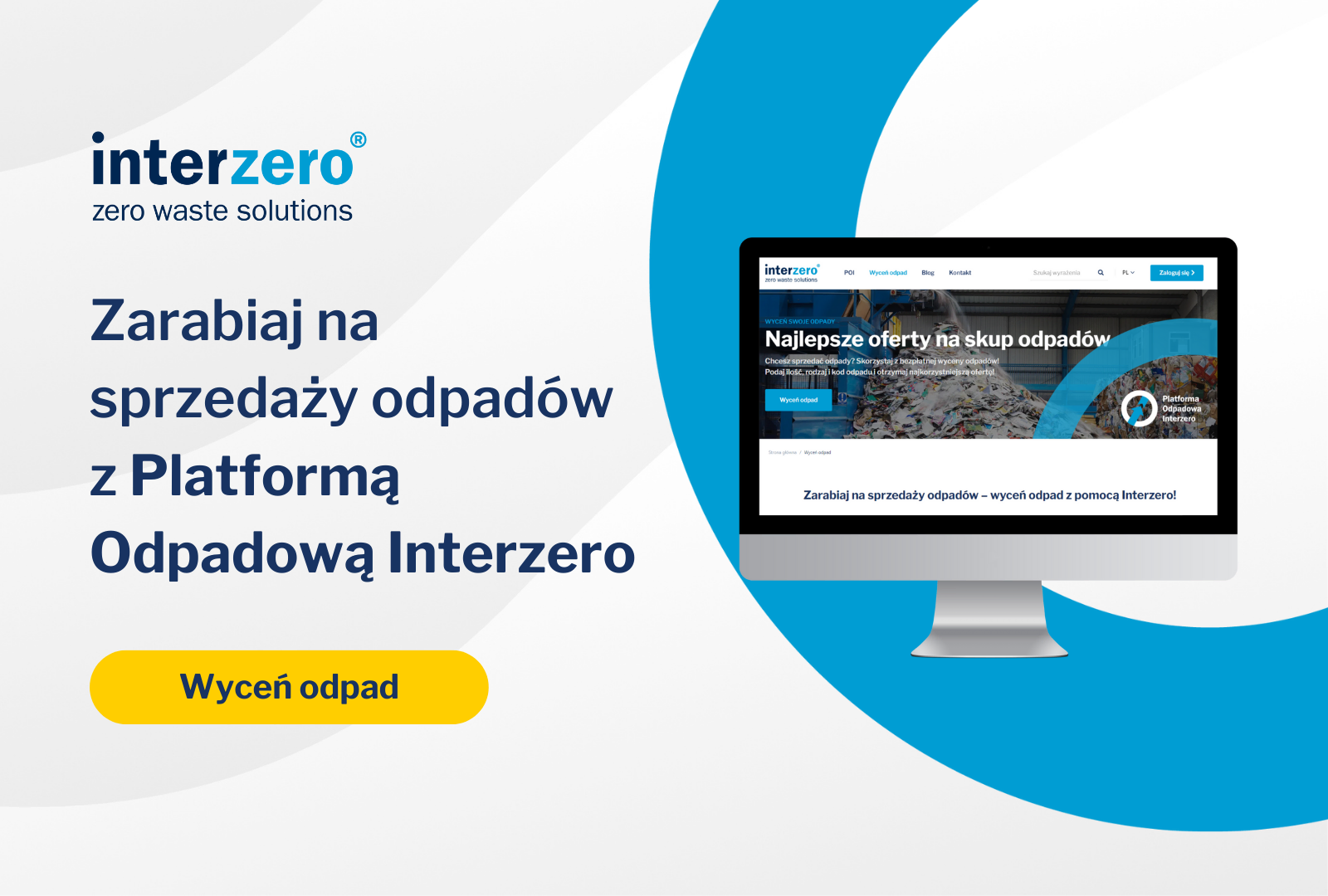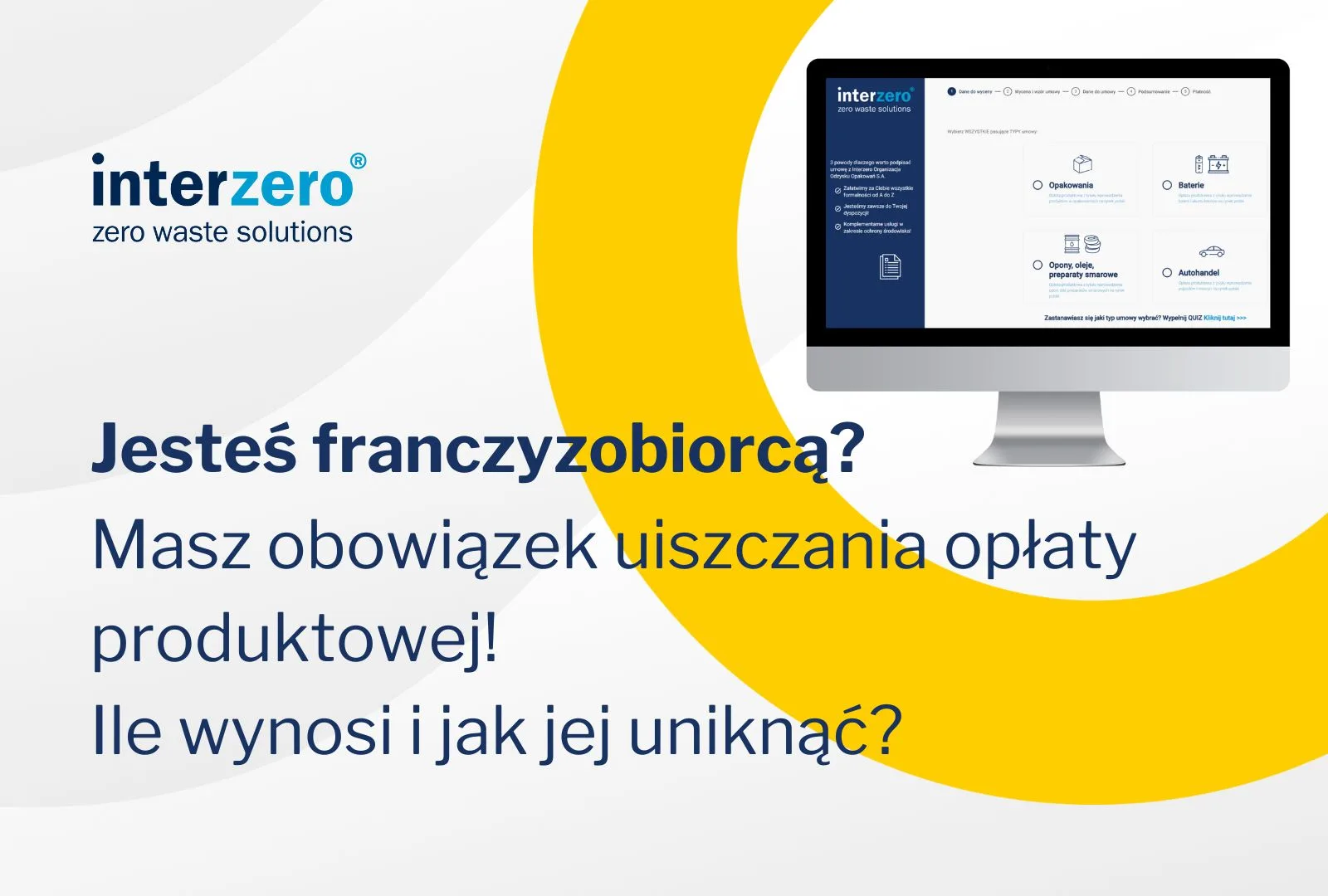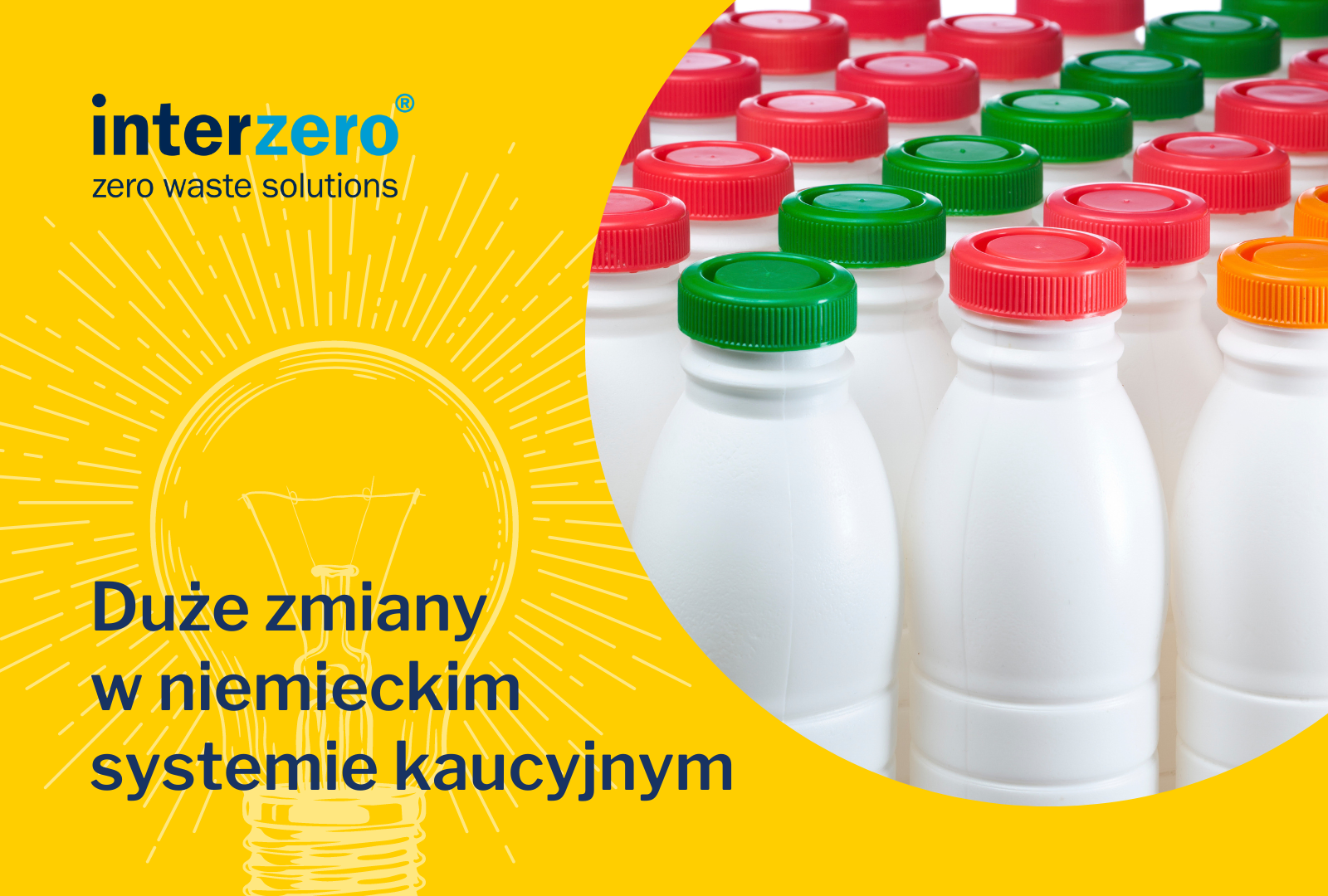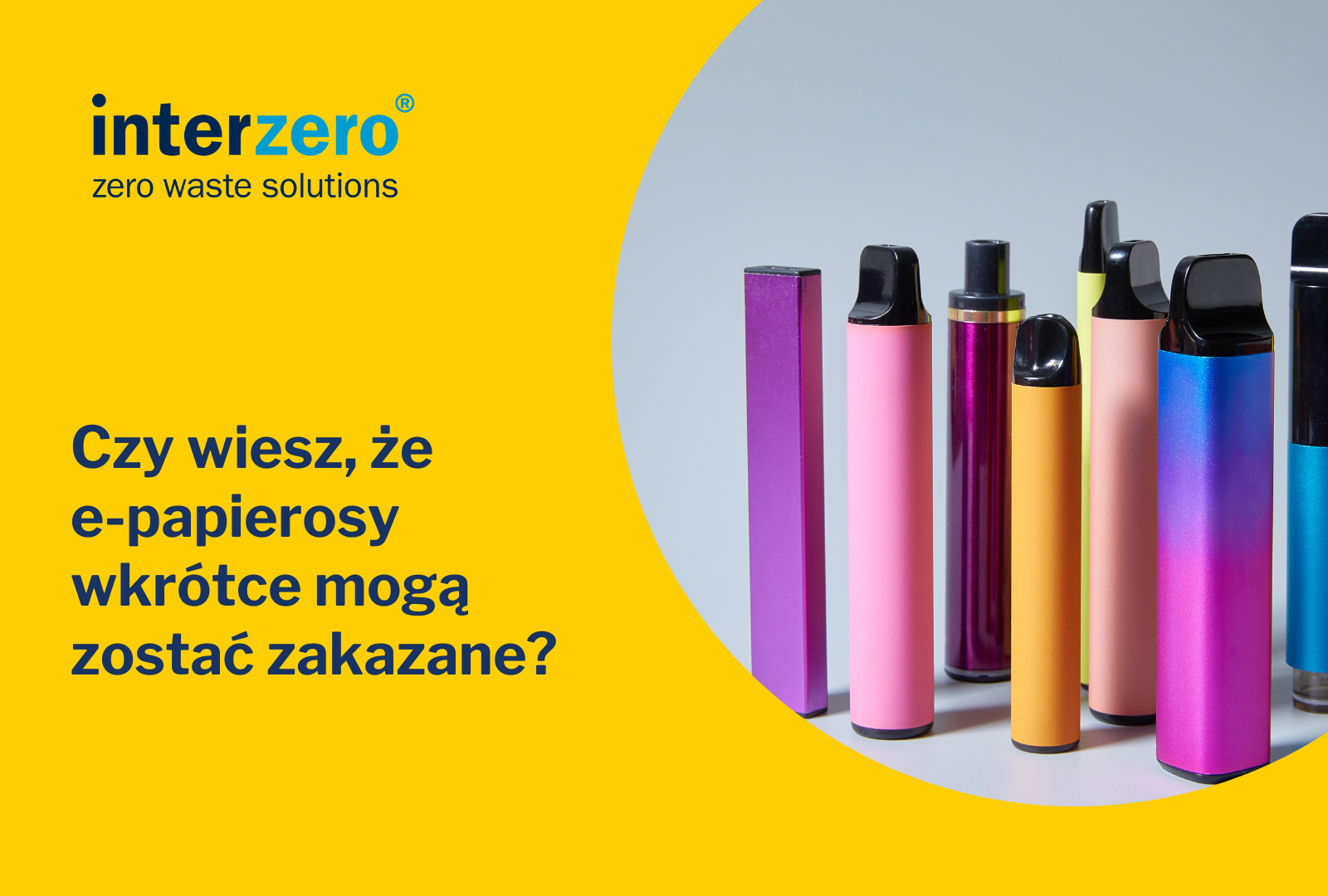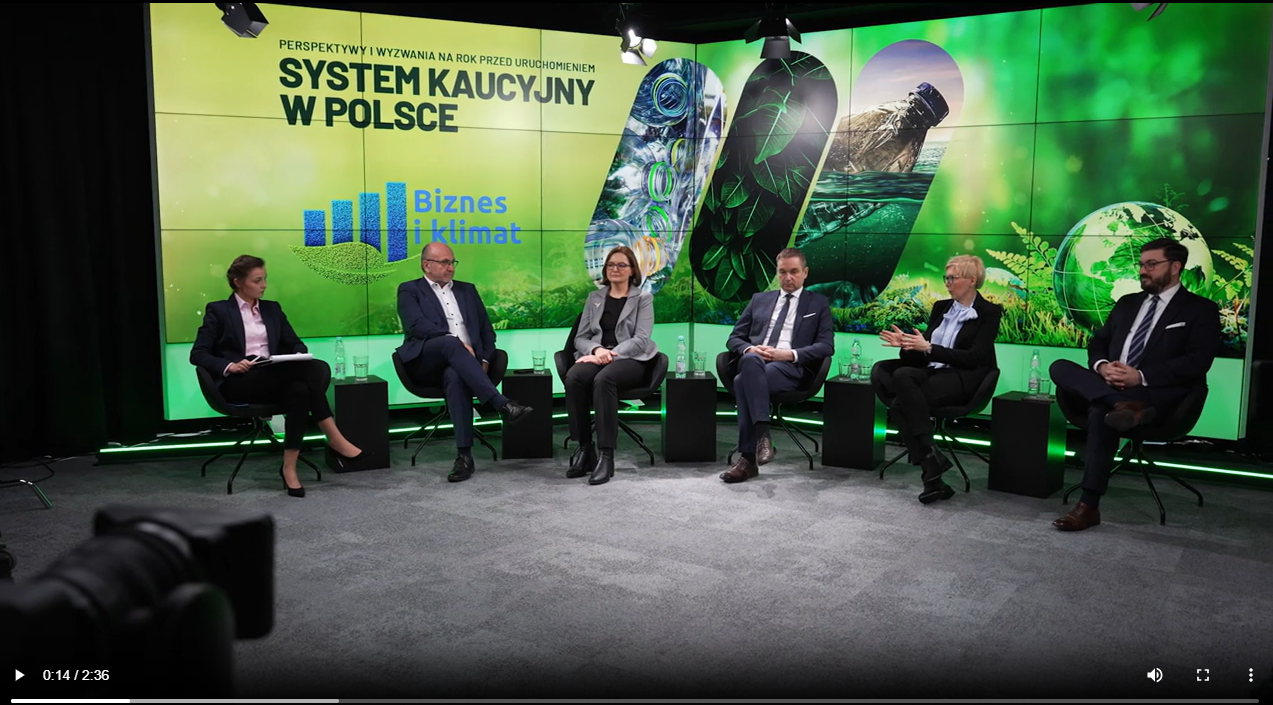Waste Valuation via Interzero Waste Platform – earn money by selling raw materials
Waste Valuation via Interzero Waste Platform – earn money by selling raw materials
The Interzero Waste Platform is a dedicated online system that enables comprehensive waste management in your company. With it, you can reduce waste management costs, automate waste records in BDO and increase revenues from the sale of raw materials.
The platform allows for automatic waste registration, planning of waste removals and generating waste removal notifications . This tool saves time and minimizes potential errors in the system.
What is waste pricing?
Waste valuation at Interzero is a convenient solution that relieves you of the burden of searching for companies offering waste collection. It is also a way of earning money from raw materials. If you produce or store types of waste that are valued by recyclers, you can sell them for a profit, and at the same time save on waste disposal and logistics costs. The Interzero Waste Platform allows you to compare prices and choose the best offer .
Just fill out the form, provide the type and quantity of waste, and our specialists will contact you. You can also attach a photo of your waste if you have trouble determining the correct code!
The platform generates transparent cost reports, allowing you to quickly obtain the information you need. You can track revenues and costs related to transferred waste and municipal payments for municipal waste collection.
If you need more information, please visit the Interzero Waste Platform website .
Franchise Product Fee | Pass on the obligation to Interzero
Franchisee Product Fee: How Much Is It and How to Avoid It?
Entrepreneurs running franchise outlets often offer their customers drinks and food in single-use takeaway packaging. Such packaging is subject to a recycling obligation or a product fee (in the event of failure to achieve the required level of recycling), which should be paid by the franchisee, not the franchisor. How much is the product fee and can the franchisee avoid it?
Division of responsibilities between franchisee and brand owner
Running a franchise outlet removes many responsibilities from the entrepreneur. The franchisee usually does not have to worry about, among other things, developing their own business model, designing new services, expanding the product portfolio or acquiring technical support and IT tools. These and other tasks specified in the agreement are usually performed by the franchise partner in exchange for periodic license fees.
However, it should be remembered that the franchisor does not take over all the obligations of the franchisee – if you run a franchise point, you still have to fulfil, for example, environmental obligations resulting from the act on the management of packaging and packaging waste. One of them is the obligation to achieve the required level of recycling or pay a product fee for the introduced packaging.
Are you a franchisee? You are obligated to pay a product fee!
Every entrepreneur introducing products in packaging must take responsibility for the waste that is created from this packaging. It can do this in two ways: by ensuring the recycling of this waste or by paying a product fee for each kilogram of the unrealized level of recycling. Contrary to appearances, This obligation applies not only to producers, but also to franchisees who sell drinks and food in takeaway packaging. .
If you run a franchise outlet where you sell, for example, coffee, meals or snacks in packages, the obligation to account for these packages rests with you, not the franchisor. This does not change even the fact that you sell all these products under the franchisor’s brand.
In accordance with applicable law, every franchisee introducing packaged products must:
- ensure the recycling of packaging waste generated from them,
- pay a product fee (if the required recycling level is not achieved),
- conduct or finance public education campaigns.
These obligations result from the provisions of the Act on the management of packaging and packaging waste. According to the opinion from LEX Environmental Protection Law:
The entity running the gas station is responsible for the packaging of meals served at the station.
Source: https://www.prawo.pl/biznes/kto-ponosi-oplate-produktowa-za-opakowania-jedzenia-na-stacji,169823.html
Similarly, these regulations apply to companies running other franchise outlets and serving, for example, drinks in takeaway cups.
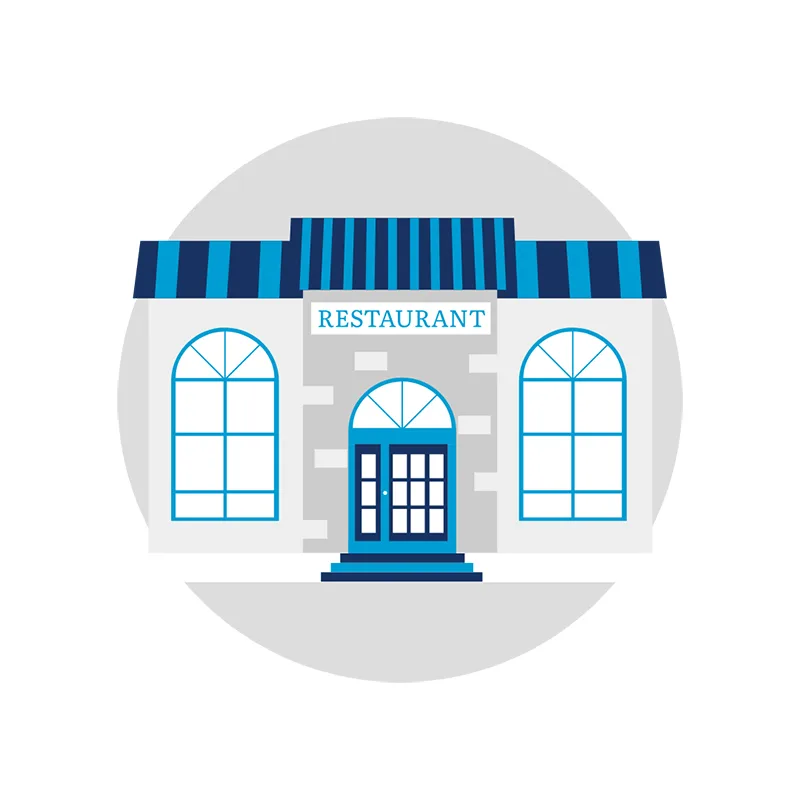
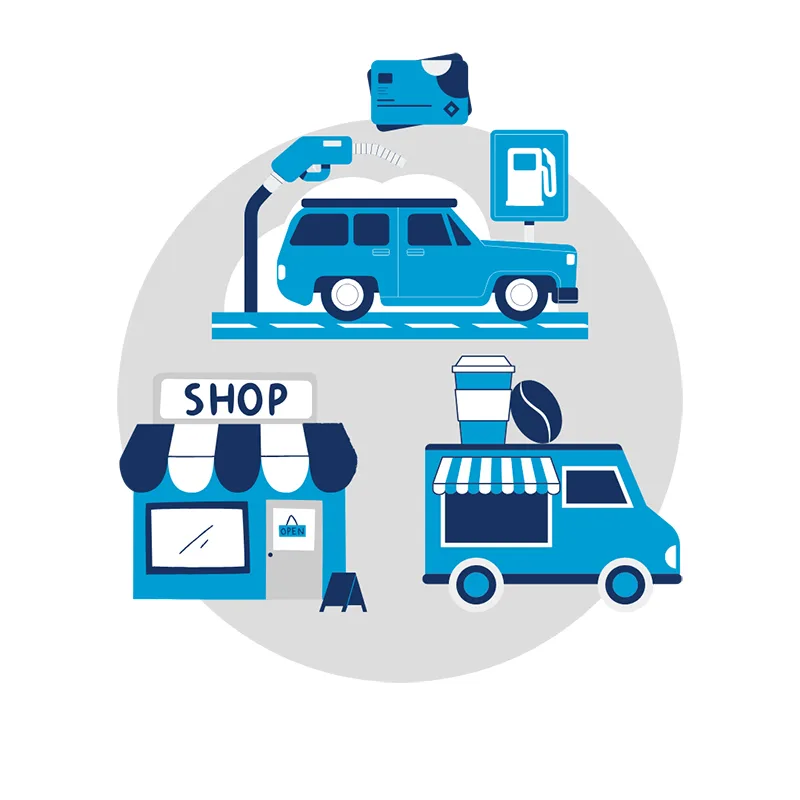
Does the mandatory product fee only apply to franchises?
NO. The obligations: recycling and paying the product fee apply to all entrepreneurs indicated in the act. However, our experience shows that it is the franchisees who are often unaware of their obligations . Many entrepreneurs running franchise outlets wrongly assume that recycling and the product fee remain with the franchisor, whose logo appears on all beverage and food packaging. Such ignorance often has unpleasant consequences – failure to meet environmental obligations results in the immediate necessity to pay a high product fee, and in some cases also in the imposition of a financial penalty.
Let us remind you: the obligation to ensure the recycling of packaging waste and pay the product fee may also apply to franchisees operating:
- restaurants, pizzerias and other catering outlets,
- cafes (including mobile ones!), drink points (e.g. bubble tea),
- gas stations,
- shops,
- bakeries and confectioneries.
The above calculation is only an example – the mandatory product fee may also apply to other companies. It is also worth remembering that the act provides for a number of exemptions from the obligation to pay the product fee.
Want to check if the product fee also applies to you?
What packaging is covered by the product fee?
The product fee for packaging and packaged products is covered by among others all packaging used for takeaway food and drinks, e.g.:
- cups for drinks,
- cup lids and covers,
- dishes, e.g. plates, bowls,
- food containers (with or without lid): boxes, trays, boxes, buckets, paper packaging for popcorn or fries.
As a franchisee introducing products in packaging, you are required to keep records of this packaging, broken down by the type of material from which it was made. Such records are the basis for determining the amount of the product fee due, which is calculated based on the weight of the introduced packaging for which the entrepreneur has not achieved the statutory level of recovery and recycling.
Product fee amount – how much will the franchisee pay?
Individual packaging materials are subject to different product fee rates. In the case of the most popular types of takeaway food and drink packaging, the product fee rates are as follows:
- plastic packaging – PLN 2.70/kg,
- paper and cardboard packaging – PLN 0.70/kg,
- multi-material packaging – PLN 1.70/kg,
- wooden packaging – PLN 0.30/kg,
- other packages – PLN 1/kg.
Although the amounts for 1 kg of packaging are not very large, the sum of the product fee for the entire year often makes entrepreneurs dizzy . Importantly, the product fee for packaging can be avoided by fulfilling the recycling obligation. Each entrepreneur can do it on their own, ensuring recycling of 100% of the introduced packaging or with the help of the Interzero recovery organization, without worrying about minimum recycling levels.

Pass on the responsibility to Interzero and avoid the product fee
Fulfilling environmental obligations is only a small fraction of all the challenges you face as an entrepreneur and franchisee. Fortunately, you can delegate some of your responsibilities to Interzero’s environmental experts. This will save you not only time, but also money – for a small fee , we will take over your obligation to recycle packaging waste, and you will avoid a high product fee .
By entrusting your responsibility to Interzero, you will gain:
- fixed, low cost of taking over the obligation,
- the ability to conclude an online contract in 3 simple steps,
- official confirmation of the correct performance of the obligation for a given year,
- convenient access to documents related to the assumption of the obligation via the Moje Interzero portal,
- a certificate for your company and an annual report on the conduct of Public Education Campaigns.
Check how much you can save by transferring your recovery and recycling obligations to Interzero!
Big changes in the German deposit system!
Big changes in the German deposit system!
From January 1, 2024, the German Pfandsystem also covers selected bottles of milk and similar drinks.
The German deposit system (Pfandsystem) has been in operation for almost 20 years and covers plastic bottles, aluminum cans and glass bottles. From January 1, 2024, it covers another group of packaging – from now on, German stores will charge a deposit of €0.25 for bottles of milk and similar drinks with a capacity above 0.1 L.
The new deposit includes, among others:
- Milk bottles;
- Milk-based beverage bottles;
- Bottles of cocoa and coffee drinks with milk content above 50%;
- Bottles of drinking yogurt and kefir.
New regulations have been introduced by the largest German supermarkets. In its current form, the deposit system in Germany covers almost all non-returnable drinks in bottles and cans.
The Polish deposit system for returnable packaging will start in 2025. The deposit obligation will apply to single-use plastic bottles for beverages with a capacity of up to 3 L, reusable glass bottles for beverages with a capacity of up to 1.5 L and metal packaging for beverages with a capacity of up to 1 L. Interzero, together with the Polish Chamber of Packaging Recovery and Recycling, will create a deposit system – read more HERE .
Did you know that e-cigarettes may soon be banned?
Did you know that e-cigarettes may soon be banned?
According to a study conducted by the Institute of Economic Planning and Analysis (IPAG) on the sale of e-cigarettes, over 100 million disposable e-cigarettes were sold in Poland in 2023. At the same time, according to an article published in The Lancet, e-cigarettes pose an increasing challenge to our environment. The first problem is the generation of a significant amount of plastic, especially in the case of cartridges that are intended for single use and are made of hard-to-degrade plastics.
The second problem is electronic waste. Research conducted by the Material Focus organization has shown that in the UK alone, 1.3 million such devices end up in landfill every week, even though they should be sent to e-waste collection points. Improper disposal of batteries and other components may lead to fires and environmental pollution.
Nicotine is also a problem, not only because it is addictive, but also because it is considered hazardous waste in some countries. Therefore, plastic containers in which liquids and e-cigarette cartridges are stored cannot be recycled.
At the end of January, the British government announced its plan to ban the sale of disposable electronic cigarettes, which will have a positive effect not only on the environment, but also on the health of the entire society. Last week, the Polish Deputy Minister of Health also announced that the possibility of a complete ban on the sale of e-cigarettes is being considered.
Source: https://www.pap.pl/aktualnosci/e-cigarettey-najlepsze-szkodliwym-dla-srodowiska-produktem-jaki-cześni-powstal , https://next.gazeta.pl/next/7,151003, 30672748,there will be a total ban on the sale of e-cigarettes-resort-zdrowie.html .
Amendment to the regulations implementing the deposit system in Poland and changes in waste management
Amendment to the regulations implementing the deposit system in Poland and changes in waste management
On February 14, a press conference was held during which the Deputy Minister of Climate and Environment, Anita Sowińska, talked more about waste management solutions, changes in the BDO system, as well as about the planned implementation from 2025. deposit system.
During the event, the Deputy Minister emphasized that the deposit system, as assumed, would be launched at the beginning of 2025, but we can expect amendments regarding the system operators. The representative of the ministry emphasized that these changes would only be „technical”. This will concern obligations and documents submitted to control the system.
On March 5, there will be a consultation meeting with the industry, local government officials and trade representatives regarding changes to the Deposit Act. The deputy minister added that the deposit system, although it will start on January 1, 2025, „may happen that it will not be perfect from the very beginning, because the act requires some adjustments.”
The deputy minister also informed about planned changes in the BDO system . The modernization will respond to the main needs of users of this system. The changes will include, among others: development of the Report Module and introduction of new functionalities in the Account Management Module.
The press conference participants were also presented with the expanded composition of the Advisory Team on waste management solutions. The advisory staff will include: Lewiatan Confederation, UNEP/GRID-Warsaw, INNOWO Institute for Innovation and Responsible Development, Polish Chamber of Waste Management, Polish Recycling Association and the National Fund for Environmental Protection and Water Management, as well as more representatives of the entrepreneurs’ side, mainly from the recycling industry, as well as non-governmental organizations and institutes.
Source:
https://zielona.interia.pl/smieci-plastik/news-system-kaucyjny-nie-ruszyl-a-juz-ma-byc-poprawka-wiceministr,nId,7335652#google_vignette
https://www.gov.pl/web/klimat/wiceministra-anita-sowinska-o-rozwiazaniach-w-zakresie-gospodarki-odpadami
Video: Dziennik Gazeta Prawna
As Interzero, we are happy to participate in debates and meetings with the ministry and industry representatives to better clarify our mutual needs and discuss current legal changes. We encourage you to read the summary of the debate „Deposit in a year, and the system in its infancy” on Dziennik Gazeta Prawna HERE , where Paweł Sosnowski, Management Board Representative for Environmental Regulations with Interzero had the opportunity to discuss issues related to the deposit system together with: Andrzej Gantner, Vice-President and General Director at the Polish Federation of Food Producers Association of Employers, Anita Sowińska, Undersecretary of State at the Ministry of Climate and Environment, Joanna Kasowska, Director of Quality and Food Management Standards , Żabka Group; Filip Piotrowski, Climate Leadership, UNEP/GRID-Warszawa; Anna Larsson, Director of Implementation of circular economy models, Reloop Platform.
Entrepreneur! Remember about the annual BDO fee!
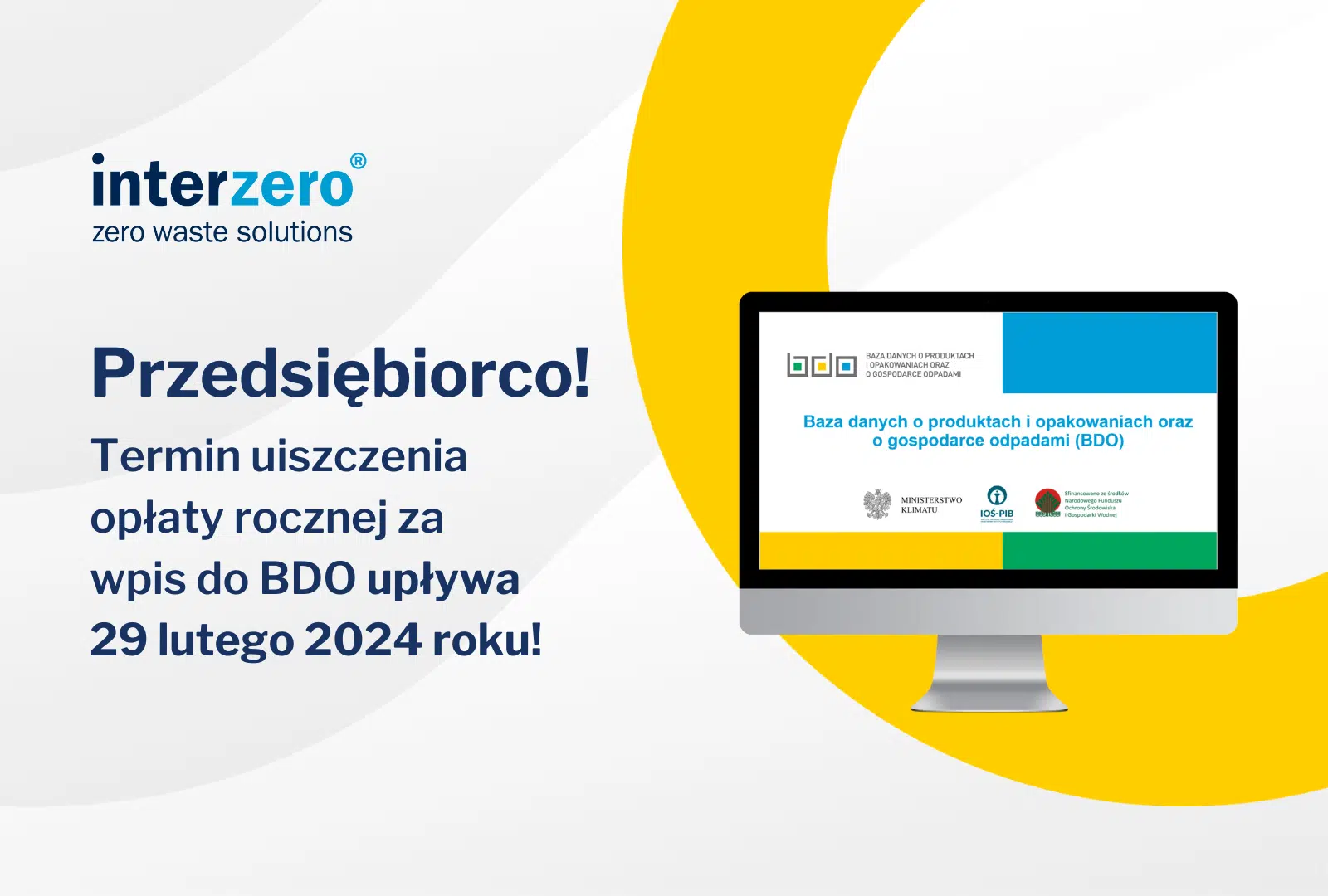
Entrepreneur! Remember about the annual BDO fee!
February 29 is the deadline for paying the annual fee for entry into the BDO in the amount of PLN 100 (micro-entrepreneurs) or PLN 300 (entrepreneurs other than micro-entrepreneurs). The fee should be paid to the account of the marshal’s office competent for the company’s registered office or place of residence.
Failure to pay the fee will result in removal from the Database on Products, Packaging and Waste Management (BDO) , and the business activity will be subject to a high financial penalty!
Entrepreneurs are subject to registration and annual fees:
- introducing electrical and electronic equipment and authorized representatives,
- introducing batteries or accumulators,
- introducing vehicles,
- producer, importer and intra-Community buyer of packaging,
- introducing products in packaging into the territory of the country,
- introducing tires into the territory of the country,
- introducing lubricating oils into the territory of the country.
Are you looking for support during the reporting period ?
Watch the free Interzero webinar „Everything you need to know about BDO”
More training at a favorable price can be found HERE
Did you know that one of the European countries can benefit 100 percent? from renewable energy by 2025?
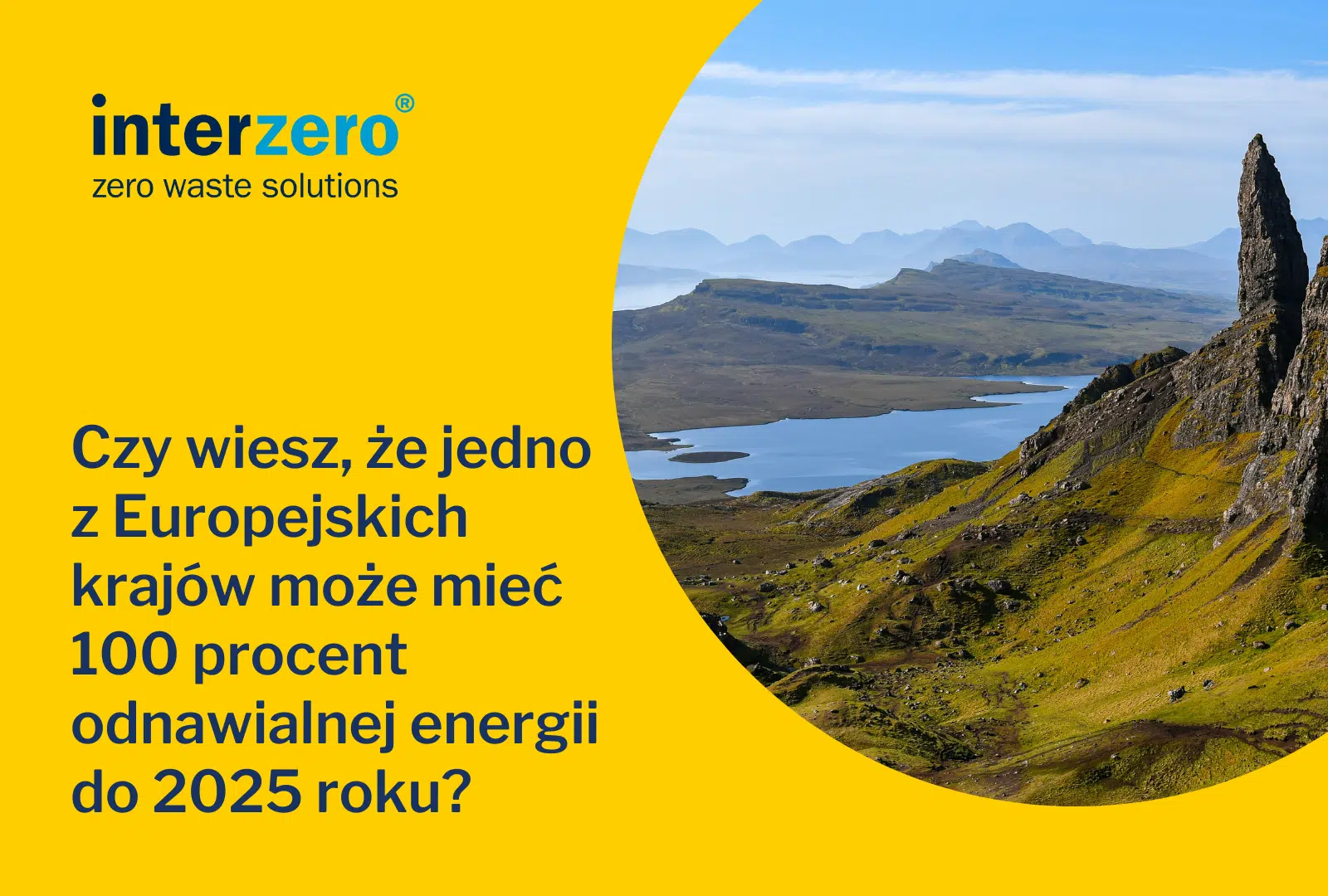
Did you know that one of the European countries can benefit 100 percent? from renewable energy by 2025?
Since March 2016, no coal-fired power stations have been operating in Scotland. Then the Longannet power station, located north-west of Edinburgh, which had been operating since 1973, was closed. This means that after 115 years, Scotland has stopped generating electricity from burning coal.
Statistics show that the share of renewable energy in Scotland’s total electricity consumption was 97.4%. in 2022, while a year earlier it was 90.1%. Scotland owes this result primarily to the development of onshore wind farms, which provided approximately 70%. green energy in the country. The remaining 30 percent provided offshore wind farms and hydroelectric power plants.
Scottish Renewables, the renewable energy industry association in Scotland, highlights how much progress has been achieved over the last decade. In 2011, the share of energy from renewable sources in the overall energy balance was only 37%.
The latest data shows that Scotland can benefit from 100%. from renewable energy by 2025 and even start transporting the surplus to other countries.
Plans include the installation and commissioning of a new wind farm of 60 SG 14-222 DD turbines for Moray West, an offshore wind farm owned by Ocean Winds, located off the coast of north-east Scotland in 2024. Each turbine will have an individual power of 14.7 MW; At the moment, it is the most powerful wind turbine ever created. Currently, Scotland is close to achieving the goal of full use of energy from renewable sources in the national electricity sector, and by 2030 the Scottish authorities plan to achieve a 50% share of renewable energy in the total consumption of electricity, heat and transport. The long-term goal is to achieve almost complete decarbonization by 2050.
Made4Loop – the answer to the new SUP responsibilities
Made4Loop – the answer to the new SUP responsibilities
Although the era of free disposable cups is slowly coming to an end, the changes do not have to mean a chaotic revolution in the company.
From July 1, 2024, entrepreneurs selling drinks in disposable cups will have to provide their customers with alternative packaging that will be more environmentally friendly. This change aims to reduce the amount of plastic waste and is one of the most controversial legislative moves regarding environmental protection in recent years. Although for many it may seem like just another legal and office formality, business owners may lose sleep because it means the need to take decisive action and look for effective solutions.
Therefore, entrepreneurs may consider introducing reusable packaging or packaging made of other materials, including oxo-degradable plastics. Alternatively, they may decide to introduce a deposit system for reusable packaging, which would allow them to be returned and reused.
That is why the Interzero service was created, based on a deposit system for reusable packaging. The Made4Loop model involves the use of reusable cups and packaging, which customers rent for a deposit and then return via a deposit system. In this way, the packaging remains in a closed loop and is reused dozens, if not hundreds of times.
You can find out more in the press release HERE
We would like to remind you that on February 22 there will be a webinar during which Zbigniew Skowronek himself will talk more about the Made4Loop service from Interzero. Registration at the link HERE
Did you know that an American startup turns bottles into ecological sand?
Did you know that an American startup turns bottles into ecological sand?
The problem of the lack of sand as a natural raw material is very big. According to statistics, the demand for sand is approx. 30-50 billion tons per year. And although this material is renewable, not in the quantities we need today. That’s why the Glass Half Full startup tackled such an important topic as glass sand recycling.
Even one glass bottle thrown into the city waste bin will result in its contents ending up in a landfill, where they will never decompose. New Orleans spends millions of dollars annually on landfills and on importing sand.
Franziska Trautmann, who is the founder and CEO of Glass Half Full, said that after the beer bottles are collected and sorted, the glass is processed by pulverizing it using hammer crushers at a local facility on Louisa St. The crushed product is later screened to remove labels and sorted into different sized granules. Finally, we get sand products – from super soft, resembling sand on a warm beach, to thick glass gravel.
Sand and crushed stone can be put to countless uses. From shoreline restoration and disaster relief to flooring and new glass products.
Within 2 years, 4 million bottles were collected in New Orleans. In this way, glass „waste” is transformed into a resource that actually benefits the community.
Source: https://glasshalffull.co/ .
Entrepreneur! Remember to submit a report in Moje Interzero!
Entrepreneur! Remember to submit a report in Moje Interzero!
We would like to remind you that the annual report submission period is now underway. Therefore, please provide the actual weights of packaging, products and batteries introduced by your company in 2023. We need these messages to fulfill the obligations you have entrusted to us.
Data must be completed by January 31, 2024. via the My Interzero customer portal.
At this link you will find clear instructions that will help you efficiently complete the report on the Moje Interzero customer portal. If you have forgotten your password or login, you will find information there on how to recover it.
Log in to the Moje Interzero platform and submit your 2023 report NOW .
If you have any problems, please use the instructional videos in the help tab HERE

